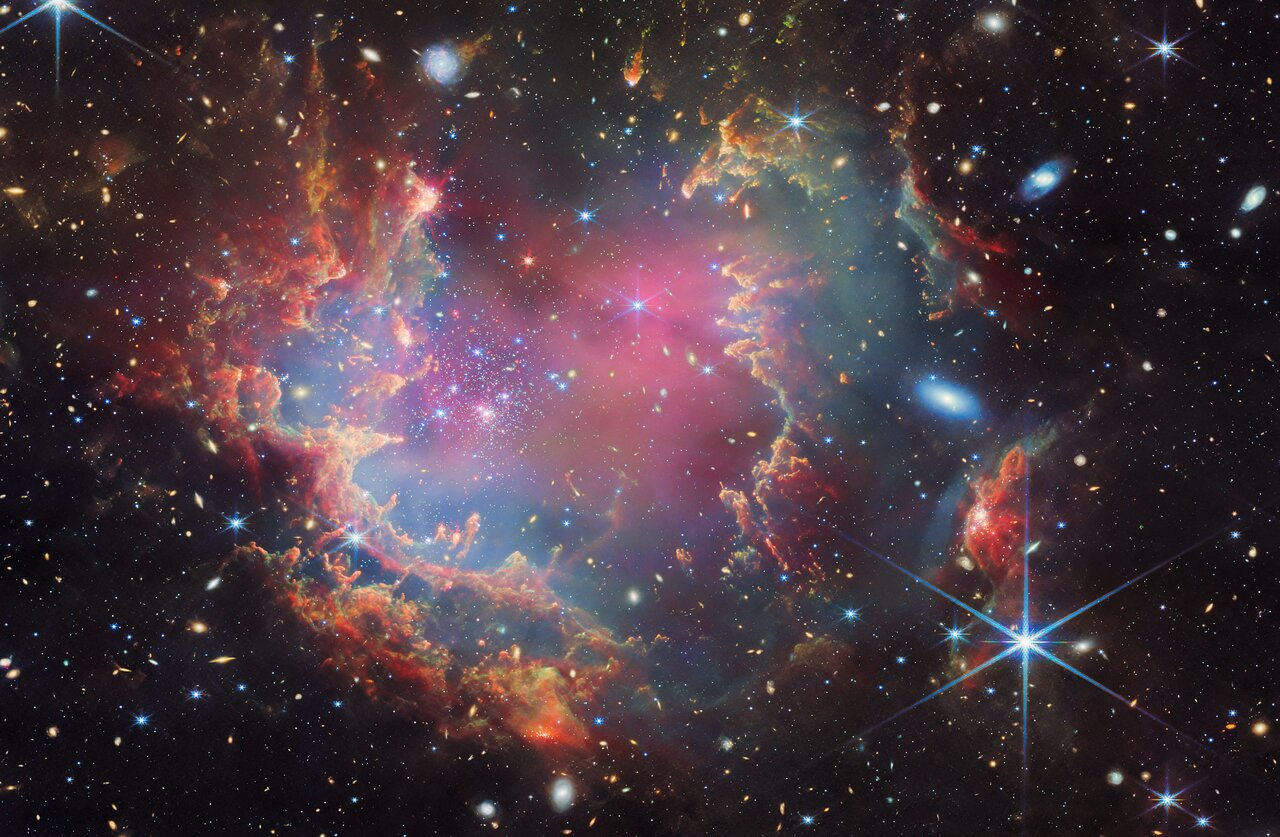About the Object
Coordinates
| Position (RA): | 1 29 23.60 |
|---|---|
| Position (Dec): | -73° 33' 39.58" |
| Field of view: | 4.43 x 2.90 arcminutes |
| Orientation: | North is 8.7° right of vertical |
Colours & filters
| Band | Wavelength | Telescope |
|---|---|---|
| Infrared | 1.15 μm | James Webb Space Telescope NIRCam |
| Infrared | 1.4 μm | James Webb Space Telescope NIRCam |
| Infrared | 1.5 μm | James Webb Space Telescope NIRCam |
|
Infrared
methane | 2.1 μm | James Webb Space Telescope NIRCam |
| Infrared | 2.77 μm | James Webb Space Telescope NIRCam |
|
Infrared
PAH | 3.35 μm | James Webb Space Telescope NIRCam |
| Infrared | 3.56 μm | James Webb Space Telescope NIRCam |
| Infrared | 4.8 μm | James Webb Space Telescope NIRCam |
|
Infrared
Silicate | 10 μm | James Webb Space Telescope MIRI |
NGC 602 (NIRCam and MIRI image)
Near the outskirts of the Small Magellanic Cloud, a satellite galaxy roughly 200 000 light-years from Earth, lies the young star cluster NGC 602, which is featured in this new image from the NASA/ESA/CSA James Webb Space Telescope. This image includes data from Webb’s NIRCam (Near-InfraRed Camera) and MIRI (Mid-InfraRed Instrument).
The local environment of this cluster is a close analogue of what existed in the early Universe, with very low abundances of elements heavier than hydrogen and helium. The existence of dark clouds of dense dust and the fact that the cluster is rich in ionised gas also suggest the presence of ongoing star formation processes. This cluster provides a valuable opportunity to examine star formation scenarios under dramatically different conditions from those in the solar neighbourhood.
An international team of astronomers, including Peter Zeidler, Elena Sabbi, and Antonella Nota, used Webb to observe NGC 602 and detected candidates for the first young brown dwarfs outside our Milky Way.
[Image description: A star cluster is shown inside a large nebula of many-coloured gas and dust. The material forms dark ridges and peaks of gas and dust surrounding the cluster, lit on the inner side, while layers of diffuse, translucent clouds blanket over them. Around and within the gas, a huge number of distant galaxies can be seen, some quite large, as well as a few stars nearer to us which are very large and bright.]
Credit:ESA/Webb, NASA & CSA, P. Zeidler, E. Sabbi, A. Nota, M. Zamani (ESA/Webb)
About the Image
| Id: | weic2425a | |
|---|---|---|
| Type: | Observation | |
| Release date: | 23 October 2024, 17:00 | |
| Related releases: | weic2425 | |
| Size: | 8588 x 5617 px | |




